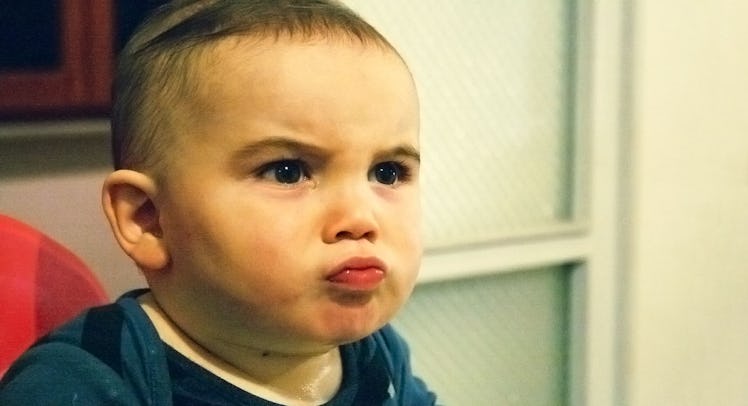5 Myths About Angry Children
Punishing them won't work.

Angry kids are frightening because they are unexpected. The gnashing teeth and glowering stares are antithetical to the supposed sweetness of childhood. The demonic child trope emerges from that unsettling contrast. And if an angry child is the stuff of nightmares for society writ large, it’s even more terrifying for the parent living with one. This leads to misunderstandings, assumptions, and illogical conclusions. False ideas about angry kids are passed around precisely because no one wants to focus on that anger, to stare it down.
That’s understandable. It’s a very human reaction to aggression and betrayal. But it’s also problematic because it allows these persistent myths to sow bad seeds.
It’s a Psychological Issue
There are many types of anger. There is the violent rage that results in a kid that bites or hits. There is quiet seething. And there’s even an angry sadness that blooms in sorrowful tantrums. Of course, any number of these behaviors being manifest on a regular basis could make a parent wonder if their kid has some sort of psychological problem.
The interesting thing is that, according to Dr. Alan Kazdin of the Yale Parenting Center, anger does not always have its roots in psychology. It can be linked to genetic predispositions for highly emotional outbursts. It can even be linked to epigenetic changes: A grandparent may have been subject to environmental stimuli that activated genetic expressions ultimately observed in their grandchildren’s struggles to handle emotions.
in some circumstances, these genetic predispositions may not even be shown unless triggered by violent media, corporal punishment, or other forms of violence. So, no, it’s not always about maladjustment.
Anger is Unpredictable
Dr. R. Douglas Fields, author of Why We Snap knows exactly from whence your kid’s anger comes. The antecedent to their angry outburst is not some mystery. That is unless the parent isn’t paying attention.
Fields notes that there are essentially nine reasons that will make people fly off the handle. Among these are threats to the self, family, stuff, and reputation. And while parents might not think withholding a toy is particularly threatening, for a kid it’s akin to being robbed at knife-point for a Lalaloopsy.
The trick is to stay observant. Yes, parents just want to get the damn shopping done, but finding the next item on the list will pull their focus. So while a kid may look like they exploded for no explicable reason, it’s more likely the setup was missed while the parent was comparison shopping baked beans.
Angry Behavior Requires Disciplinary Action
A kid exhibiting angry behavior is likely getting a huge hit of the stress hormone cortisol. The parent, shortly thereafter, is getting a hit of adrenaline. That leads to rash decisions and sometimes abuse because it reinforces a desire to discipline. It’s an impulse best held at bay. Outbursts are known to have a very specific ebb and flow. As anger subsides, sadness creeps in. When a child has calmed down, it’s time to get close and quiet in order communicate what happened. At that point, the important thing is to name the emotion. To explain that it’s understandable, and ask if there are better ways to deal with the strong feelings.
Punitive behavior, yelling, or spanking isn’t modeling the behavior a parent wants their kid to display. It reinforces that anger is an appropriate response. And, often, by responding with violence, a parent is conditioning a child to up the anger ante. Of course, in the most extreme cases, when a child is endangering themselves, or others, removing the kid from the dangerous situation is the top priority. Once they are in a safe place, the best bet is to let the storm run its course.
Anger Leads to Violence
An angry person may lash out violently. And a violent person may not actually be angry about anything. The thing for parents to understand is that they can help their child form an appropriate response to anger.
Kazdin uses a method of simulation at the Yale Parenting Center with the most violent kids he works with. It’s a very transparent technique that allows a child to respond to a situation that makes them angry in appropriate ways. This gives the kid the tools they need to succeed.
There are appropriate responses to anger. And all of them require that the anger is acknowledged. Giving a kid a chance to talk about their anger is likely to lead them away from lashing out.
They’ll Grow Out of It
Sometimes anger is simply a phase. And when a kid learns to communicate or has better tools they’ll move on. But not all kids will simply “get better.” That’s why it’s important for parents to recognize anger and have conversations about it. Because while there are genetic factors, it can also be a symptom of bigger issues.
For instance, family therapist Vicki Botnick points out that depression in young children often looks like anger and irritation. So ignoring it, trying to punish it away, or not attempting to understand its roots can place a kid in danger. While anger does not always signal a bigger issue, it’s not something to ignore.
This article was originally published on